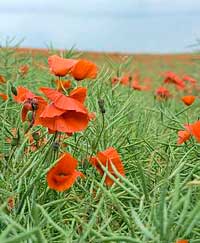Metazachlor restrictions add a new OSR challenge

The loss of valuable actives in recent years plus this season’s new restrictions on metazachlor is making weed control in oilseed rape even more challenging. Philip Case takes a look at the options
Taking a field-by-field approach when planning which pre-emergence herbicides to use this autumn on oilseed rape ground is the key to achieving effective control in problem fields.
This more targeted approach with problem fields is proving increasingly necessary following the loss of useful actives, such as trifluralin and isoproturon (IPU), and the implementation of new restrictions on metazachlor use.
Growers should first identify the mix of priority weeds, such as poppies, cleavers and cranesbill, in each field and then tailor the pre-emergence herbicide choices to target them, says Hutchinsons’ technical manager Dick Neale.
Metazachlor mixes offer good baseline control of both broadleaved and grass weeds, he advises. Where there are poppy, cranesbill or shepherd’s purse problems, Mr Neale recommends using Springbok at full dose.
Where cleavers and poppies are the main problem, Novall offers effective control. “The dose is more flexible for Novall, depending on the weeds present. If you are seeking general control with low levels of cleavers, 0.75 to 2 litres/ha should suffice. However, for high populations of cleavers and/or poppies, he reccomends the full rate (2 litres).”
Centium, Shield, or Galera are good choices for the control of mayweeds, poppies, thistles and cleavers.
Peter Dews, an agronomist working for Agrovista in the south Midlands adds that for dense broadleaf populations, growers could consider napropamide.
“It’s key strength is the improved control of cranesbill (in particular), chickweed and poppies from the standards (such as Springbok). It is also useful in bolstering the control of mayweed, speedwells, red dead nettle, blackgrass and pansy,” he said.
Mr Dews added he tended to use it at a rate of around 1.5 litres/ha with 2.0 litres/ha of Springbok and 0.2 litres/ha of the pre-emergence adjuvant Grounded.
Whatever product you opt for, the aim is to apply it to a firm, fine seedbed. Rape seed should be covered with 15mm of soil with applications made prior to the crop chitting (in practice within three days of drilling and rolling), he says.
If spraying is delayed due to poor weather or being unable to travel, metazachlor-based products, such as springbok and Oryx, can be applied post-emergence when the crop is at the expanded cotyledon stage. But mixer partners such as napropamide and clomazone must be omitted.
Herbicide options: Springbok – metazachlor + dimethenamid-p Novall/Oryx – metazachlor + quinmerac Centium/Cirrus – clomozone Shield – clopyralid Galera – clopyralid + picloram Devrinol/Associate – napropamide |
|---|
Weed control strategy
New restrictions on the use of metazachlor from this autumn will force some growers to change their weed control strategy in oilseed rape, particularly those growing rape in a tight wheat-rape rotation.
Under the new rules, growers can apply no more than 1000g/ha of the active ingredient in a three-year period on the same field.
The restrictions were introduced to reduce the risk of metazachlor reaching watercourses, as it has been found in some above EU-permitted drinking water levels, peaking in spring and autumn. The fear is that the active could be withdrawn if there is no reduction in the peaks.
“Growers are reeling from the loss of trifluralin and IPU and this will make life a little harder still,” says Dick Neale, technical manager at Hutchisons.
However, Mr Neale believes the impact on metazachlor will be “an inconvenience, but not a disaster” for the many growers who don’t grow oilseed rape in more than a one in three rotation.
But for those who are affected, Mr Neale believes it will mean selecting products formulated with lower levels of the active ingredient in combination with another active. Historically, straight metazachlor (Butisan S) has been the popular pre-emergence choice.
These changes concerning metazachlor prompted Nick Anderson, an agronomist at Suffolk’s Agrivice, to take another look at one alternative – napropamide.
Before trifluralin was revoked in 2007, products containing napropamide were used to some extent as pre-emergence options in oilseed rape, says Mr Anderson. Napropamide, which is still legally available for use as a pre-emergence herbicide on oilseed rape, has been largely overlooked since being succeeded by metazachlor.
“Napropamide has not been used widely as a chemical for a number of years, so many growers will be unfamiliar with its strengths and weaknesses and best application practices,” says Mr Anderson.
Napropamide is known to offer good control of a broad spectrum of broadleaved weeds, including mayweeds, shepherd’s needle and cranesbill.
To find out more, Mr Anderson has carried out a trial, with the aim of assessing its value as a pre-emergence treatment in winter oilseed rape, and specifically, the possible benefits of napropamide when used in conjunction with Centium/Cirrus. Results are due later this month.
Metazachlor stewardship
The Voluntary Initiative has put together best practice guidence for the use of metazachlor, including a self-assessment tool to help growers assess the risk of it reaching water courses.
For more details, visit the weblink www.voluntaryinitiative.org.uk/_Attachments/resources/1150_S4.pdf

